Unsightly brown patches can ruin the look of an otherwise beautiful green lawn. If your grass suffers from brown patches, fret not! There are many common causes and just as many fixes for brown grass. In this guide, we’ll go over the sources of discolored grass and what to do to repair your lawn.
What Causes Brown Patch Grass?
Before you address the issue of brown, dead patches in your grass, it’s important to narrow down the cause.
Common problems include brown patch fungus, overfertilizing, pests, and even your pets. Fortunately, once you find out the root of the problem, there are cures to help your lawn get back to being lush and green.
What is Brown Patch Fungus?
Patches in your lawn that start to turn yellow-sh after hot, humid weather could be a sign of brown patch fungus (Rhizoctonia solani). This disease thrives in moist conditions and will often pop up after periods of prolonged moisture exposure.
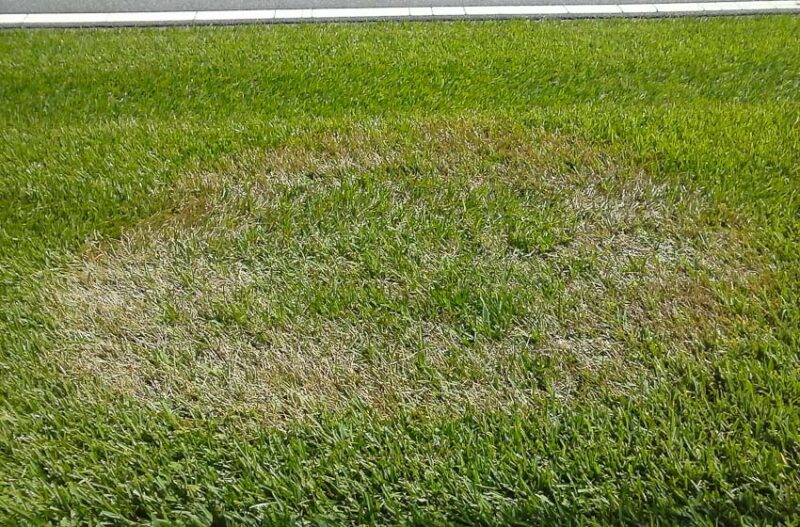
This disease affects several different types of lawn grass— both warm and cool-season grasses— when they are weakest. For example, brown patch fungus affects warm-season grasses like Bermuda grass in the spring when they’re just waking up from their dormant season.
Contrarily, cool-season grasses tend to have fungus problems during the summer for the same reason.
Signs of Brown Patch Grass Fungus
Recognizing the signs of brown patch disease is the first step to treating it. Since there are so many reasons for brown patches of dead grass, one cure can worsen another issue. Therefore, it’s important to narrow down the cause of your brown grass before jumping into a treatment.
There are several signs to look out for that can indicate brown patch fungus may be the root of your issue. Look out for:
- Circular light green patches from 2 inches up to 2 feet
- Round patches of brown grass in your lawn
- The outer edges of patches are a smoky brown or gray
- Wilting or yellowing blades of grass
- Brown or red leaf tips on grass blades
- Spotting on blades of grass
- Irregularly shaped patches of dead grass
Patches of brown patch disease have been known to grow as large as 20 feet in diameter, especially in moist, shady areas of your lawn.
Other Causes of Brown Spots on Your Lawn
While brown patch fungus is one common cause of brown grass, there are several other sources to look out for. Before you treat a fungal infection, eliminate other causes of brown patches in your lawn to minimize the chances of damage to your grass and soil.
Lawn Grubs
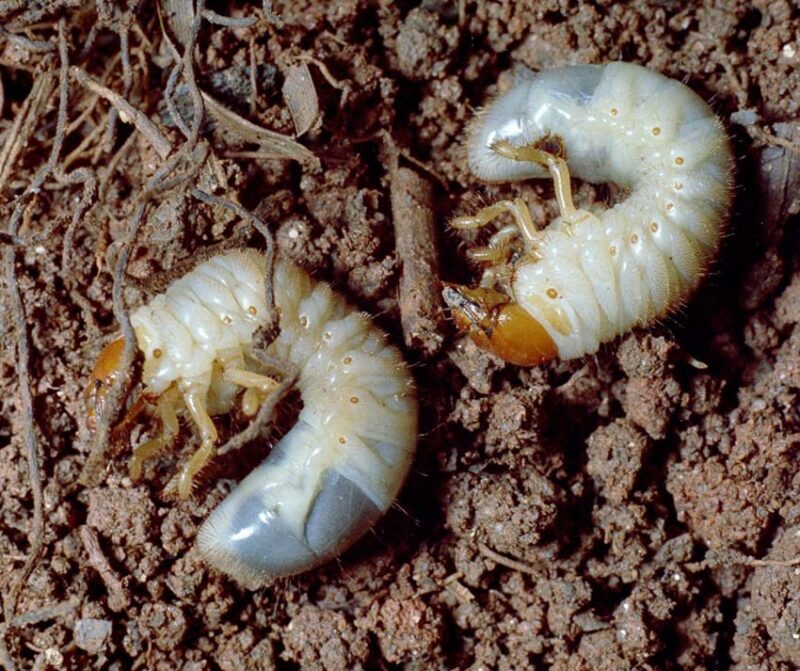
Lawn grubs can decimate the root zones of your lawn, which can cause it to turn brown and die. Thankfully, monitoring your lawn for grubs is an easy process.
To check for lawn grubs, dig a few square-foot patches in your grass and count the amount of grubs you see in each hole. If there are more than 10 grubs per square foot, you probably have a grub infestation.
Once these grubs pupate, they will emerge as adult beetles.
Some types of beetles, such as Japanese beetles, can cause damage to plants and trees, so it’s best to nip your grub problem in the bud to prevent the beetles from developing.
You may also have animals like raccoons, skunks, and moles searching your yard for grubs, which can cause more damage.
Pet Urine
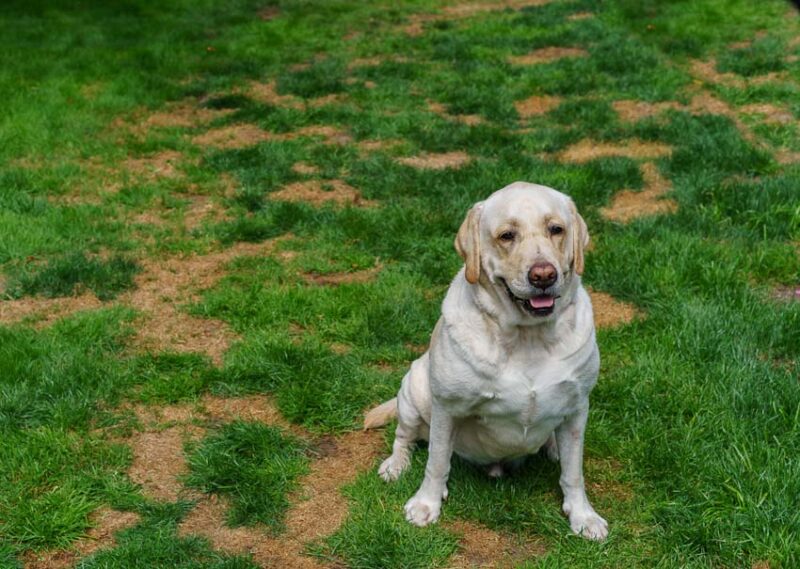
Lawn damage can be done even by man’s best friend. That’s right- your dog’s urine can cause brown patches on your lawn, especially if they use the same area every day to do their business.
Luckily, it’s easy to treat pet urine burns on your lawn by rinsing thoroughly with water, removing any dead grass and other vegetation, and planting new grass seeds.
To avoid the problem altogether, consider dog-friendly landscaping ideas, such as gravel runs or artificial grass pet areas.
Heavy Thatch
Thatch is the layer of dead grass and organic matter that lives on top of your soil. If left to build up for too long, it can cause several problems.
Heavy thatch prevents water from draining into the root zone of your lawn. If you notice water running off onto sidewalks and driveways while you water, it may be time to dethatch your lawn.
Thick thatch will, in effect, smother your lawn and prevent it from getting water, air, and nutrients. This can result in patches of brown, dead grass.
To test your thatch buildup, you can dig into your lawn and take a cross-section of soil and turf. If your thatch buildup is over half an inch thick, you should dethatch your lawn.
Soil Compaction and Erosion
Erosion happens on a small scale in your yard constantly. It happens naturally when forces like water and wind move your soil particles. If your lawn has a lot of slopes or hills, erosion is a common cause of dead, brown grass.
Soil compaction also happens naturally during times of heavy rain, but it can also be worsened by foot and vehicular traffic. When your soil gets compacted, it’s more susceptible to erosion.
The most effective way to fight erosion and soil compaction is by aerating your lawn.
Poor Soil Quality
The building blocks of a healthy lawn are fertile, healthy soil, plenty of nutrients, and a regular watering schedule. If one of those factors is off-balance, you could put your lawn at risk of damage. One common cause of brown grass is poor soil quality.
You can complete a soil test to identify the weak areas in your soil and discover which additives will help revitalize it. Liming your lawn is one of the best ways to introduce nutrients into your soil, and prevent the nutrients from becoming bound up and inaccessible to your grass.
Overfertilizing
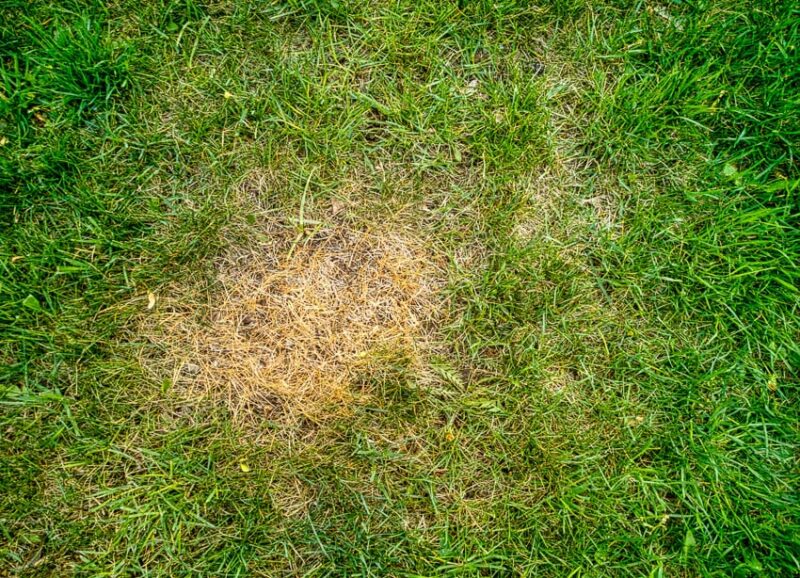
For a lawn care beginner, knowing when to fertilize your lawn can seem like a daunting task since there are so many kinds of fertilizers on the market.
There’s a lot that goes into fertilizing your lawn. If you suspect your lawn is damaged due to over-fertilization, water your grass thoroughly for a few days. Avoid fertilizing during hot, humid weather, and make a plan to stick to a strict fertilizing schedule in the future.
Dormancy
Grass naturally goes dormant during off-season periods of the year. During the summer heat, cool-season grasses will turn brown, while warm-season grasses turn brown and dormant during winter cold snaps.
As long as your soil is healthy and fertile and you’re choosing the right grass for your region, there’s not much you can do about seasonal dormancy. Your grass will bounce back lush and green when the weather becomes favorable for it to thrive.
Effective Treatments for Brown Patch Grass
Brown patch fungus rarely goes away on its own, so if you’ve narrowed down the cause of your brown grass to this disease, it must be treated correctly. Once it’s under control, executing proper lawn care practices will prevent brown patch fungus from returning.
Proper Lawn Care Practices
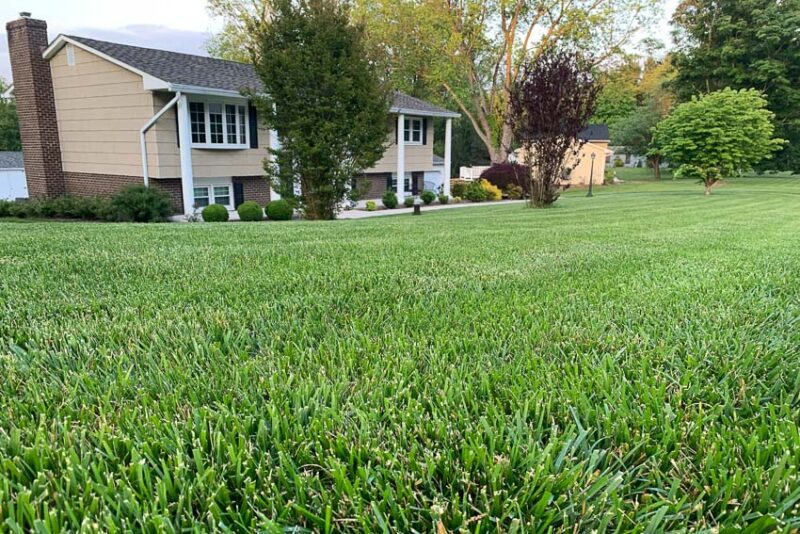
If you take good care of your lawn, it becomes more resilient to disease and fungus, including brown patch fungus. Maintain a regular schedule of watering, mowing, and fertilizing.
Deep, infrequent watering will provide your soil with the moisture it needs without creating an ideal habitat for fungus. For best results, water your lawn in the morning so it has time to dry out in the afternoon sun.
Maintaining a regular mowing schedule is important, but you must avoid cutting your lawn too short. This can make it susceptible to diseases by weakening the root system. The best length for most grasses is between 2 inches and 3 1/2 inches to increase its stress tolerance.
Before you start a fertilizing schedule, you should decide whether you want to use organic or synthetic fertilizers. Organic versions are slow-release and less likely to burn your lawn, so they’re usually preferable over synthetic chemical fertilizers.
A good rule of thumb is to test your soil once a year to make sure it’s healthy. Depending on your findings, you may need to add soil amendments or lime to your lawn to balance its pH levels.
Fungicide Application
If your lawn has had past issues with brown patch fungus, consider adding a fungicide to your lawn maintenance schedule once temperatures reach around 60°F. Continue to apply every few weeks until the conditions for brown patch fungus growth are no longer favorable.
Lawn fungus can also develop a resistance to chemical treatments, so it’s wise to alternate between different types of fungicides during the season.
Improving Air Circulation
Another way to prevent lawn diseases like brown patch fungus is to ensure your lawn has good air circulation.
When your lawn is moist, fungal infections thrive. Since many types of fungus are already in your soil, it’s important to prevent favorable conditions for fungal growth.
Reduce the time your grass is wet as much as possible. You can improve your yard’s air circulation by pruning trees and shrubs, and by switching from solid to louvered fences to allow airflow.
Aeration and Dethatching
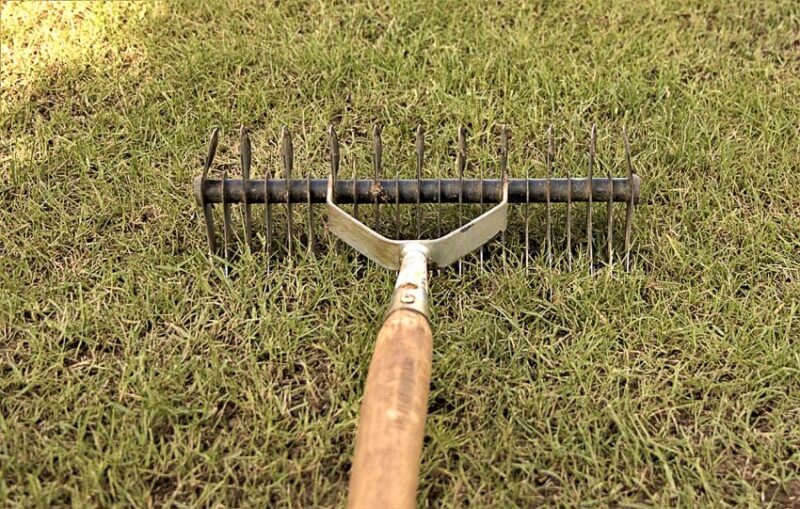
Another critical care practice to help you avoid many lawn diseases is by aerating and dethatching your lawn.
Most lawns only need to be aerated about once per year, however, if your soil is very compacted, you may need to aerate twice a year.
Dethatching is usually only required every few years, but if your thatch buildup is heavy, it could make it harder to aerate properly. Dethatching will make aerating easier, as well as improve the circulation near your grass’s root zone.
Conversely, you could switch to patio pavers or gravel walkways in areas that see a lot of foot traffic. This can help reduce the amount of soil compaction and keep your lawn protected against diseases.
Importance of Addressing Brown Patch Grass
Since lawn diseases can affect your home’s curb appeal, as well as the overall health of your lawn, addressing the cause and finding a treatment is important.
Lawn Aesthetics and Curb Appeal
Having a lush, green lawn significantly benefits your curb appeal, making your home seem inviting. It also increases your property value.
When your lawn is infected with brown patch fungus or other lawn disease, the patches of brown, dead grass are an eyesore that affects the overall aesthetic of your property.
Lawn Health and Longevity
In some cases, lawns can recover from brown patch fungus if the conditions are no longer favorable for it to spread. However, it may take a few weeks before the dead spots in your grass start to recover.
If the disease did severe damage to your grass, you may need to repair your lawn by planting new grass seed or sod.
Impact on Other Plants and Ecosystems
Grass and soil make up a micro-ecosystem that’s susceptible to damage if infected by diseases like brown patch. Once infected, your lawn also becomes prone to weed development in the dead areas of your grass.
Plus, not only is your lawn at risk, but once a lawn disease spreads to other lawns in your neighborhood, it can cause widespread damage.
Diseased lawns can also cause problems like soil erosion. Erosion affects ecosystems when rainwater carries contaminants and soil particles to nearby water sources.
FAQ: Common Questions About Brown Patch Grass Treatment
1. Can brown patch grass spread to other lawns?
Brown patch fungus can be spread by wind, foot traffic, and mowing gear. Most lawn care professionals clean and treat their mowing equipment after cutting lawns affected by fungal diseases like brown patch.
2. How quickly will my lawn recover after treatment?
After using a fungicide to rid your lawn of brown patch disease, it usually takes a couple of weeks for your grass to recover. However, it usually won’t be done growing in for a number of weeks. It may be necessary to renovate any bare patches by reseeding or laying sod.
3. Is it safe for pets and children to be on the treated lawn?
Children and pets should stay clear of areas treated with a fungicide for at least 72 hours after treatment. Be sure to also keep fungicide products away from children and pets to avoid accidental poisoning.
4. Can I prevent brown patch grass without using chemicals?
There are a few effective methods to get rid of brown patch grass without using harsh chemicals. You can apply baking soda to affected areas, either in powder form or mixed with water and sprayed onto brown patches. Vinegar is another way to control a brown patch fungus infection, however, it’s also a weed killer, so be cautious when using this method.
5. Should I remove the affected grass patches?
The main reason to remove patches of grass after a brown patch fungus infection is so that you can repair the bare spots. Once the disease kills your grass, it will take a few weeks to recover. In the meantime, those areas will be susceptible to weeds.
Related Content
Mulching Vs Bagging Grass: Which is Better for Your Lawn?
How to Plant Grass Seed
Best Time to Plant Grass



